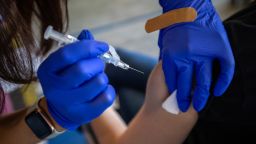Fewer than 2 in 5 adults have gotten their flu vaccine this season, and only about 1 in 6 have gotten the latest Covid-19 vaccine, according to CDC data.Francine Orr/Los Angeles Times
The US Centers for Disease Control and Prevention says there is an “urgent need” to boost vaccination coverage amid increasing levels of respiratory disease.
“Low vaccination rates, coupled with ongoing increases in national and international respiratory disease activity caused by multiple pathogens, including influenza viruses, SARS-CoV-2 (the virus that causes COVID-19), and RSV, could lead to more severe disease and increased healthcare capacity strain in the coming weeks,” the agency wrote in a Health Alert Network advisory Thursday. “In addition, a recent increase in cases of multisystem inflammatory syndrome in children (MIS-C) following SARS-CoV-2 infection in the United States has been reported.”

It’s not too late to get vaccinated, as the holidays – and respiratory virus season – ramp up
About 7 million fewer adults have gotten their flu shot so far this season compared with the last virus season. Overall, uptake is about 36% for both adults and children, according to CDC data through November 18.
Vaccination coverage for Covid-19 is also low, with just 17% of adults and about 8% of children getting the latest shot, according to CDC data through December 2. That includes about 36% of seniors, who are at higher risk for severe disease.
Also, only about 16% of older adults ages 60 and up have gotten the new RSV vaccine.
Key reasons for low vaccination rates include a lack of provider recommendation, concerns about side effects, and a lack of time or forgetting to get vaccinated, according to findings from a nationally representative survey of US adults that were shared in the CDC advisory.
“We are seeing too few folks get vaccinated this season,” CDC Director Dr. Mandy Cohen said at a briefing with the American Medical Association on Tuesday. “The voice of the physician matters so much in whether or not folks decide to get vaccinated.”
The CDC recommends the flu and Covid-19 vaccines for everyone ages 6 months and older, and the new RSV vaccine is available for adults 60 and up.

You can get Covid-19 and flu vaccines at the same time, but should you? What the science says
Immunization helps prevent hospitalization and death from respiratory disease, and it’s especially important for those at increased risk for severe disease, including infants, older adults, pregnant people and those with certain underlying medical conditions.
“About 70 to 80% of American adults over the age of 18 have at least one condition that puts them at higher risk of a bad outcome,” Cohen said. “Getting vaccinated decreases your risk of hospitalization and death at every age, including 18 to 64, but it also decreases your risk of long Covid.”
About 1 in 7 adults who have had Covid-19 report long Covid symptoms, including ongoing fatigue or cough, which can develop even after a mild illness, she said.
Children are less likely to have severe outcomes, but emergency department visits and hospitalizations for respiratory disease are rising across age groups, CDC data shows
In the past four weeks, hospitalizations increased 200% for flu, 51% for Covid-19 and 60% for RSV, according to the advisory. There have been 12 reported pediatric influenza deaths and 30 reports of MIS-C, a rare complication that typically happens a month after a Covid-19 infection.
Respiratory disease activity in the US is highest in the South but quickly rising in Northern states.
The CDC recommends that people talk with their health care providers about the vaccines that are recommended for them and their families. Locations offering the seasonal vaccines can be found on Vaccines.gov, and uninsured adults can receive Covid-19 vaccines at no cost through the CDC’s Bridge Access Program.
Everyday prevention measures, such as covering coughs and sneezes, washing hands and staying home when sick, can also help reduce the spread of illness.
“These tools that protect us – vaccines … testing and treatment and washing hands and ventilation and masks – all of these things are layers of protection that help make sure that we can weather this season,” Cohen said.







